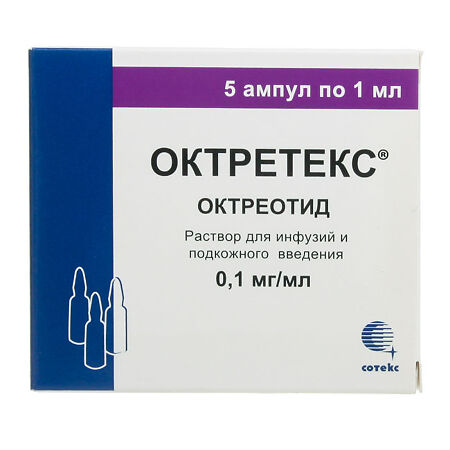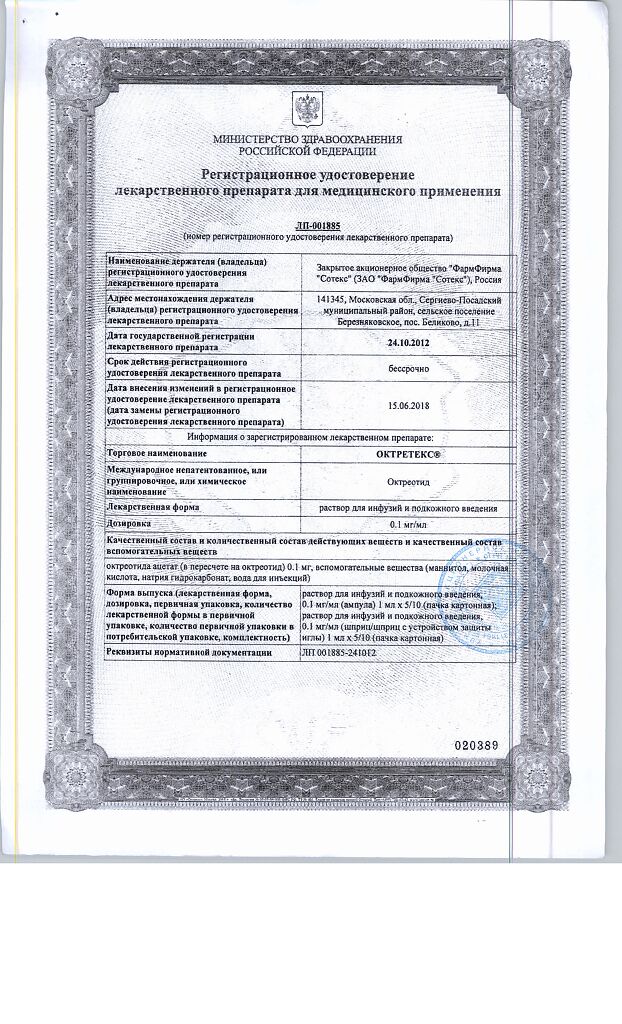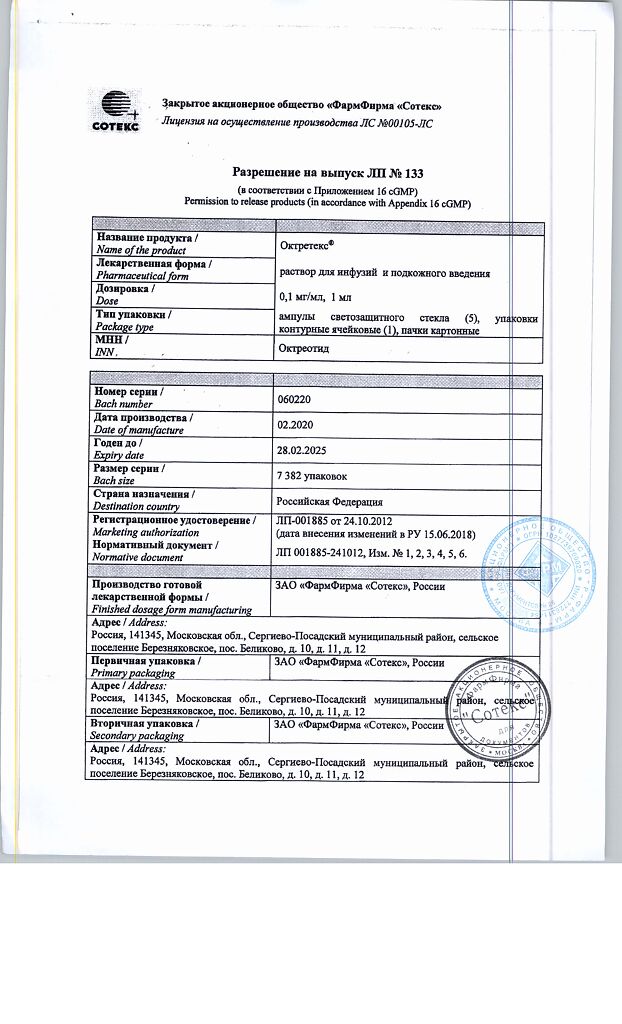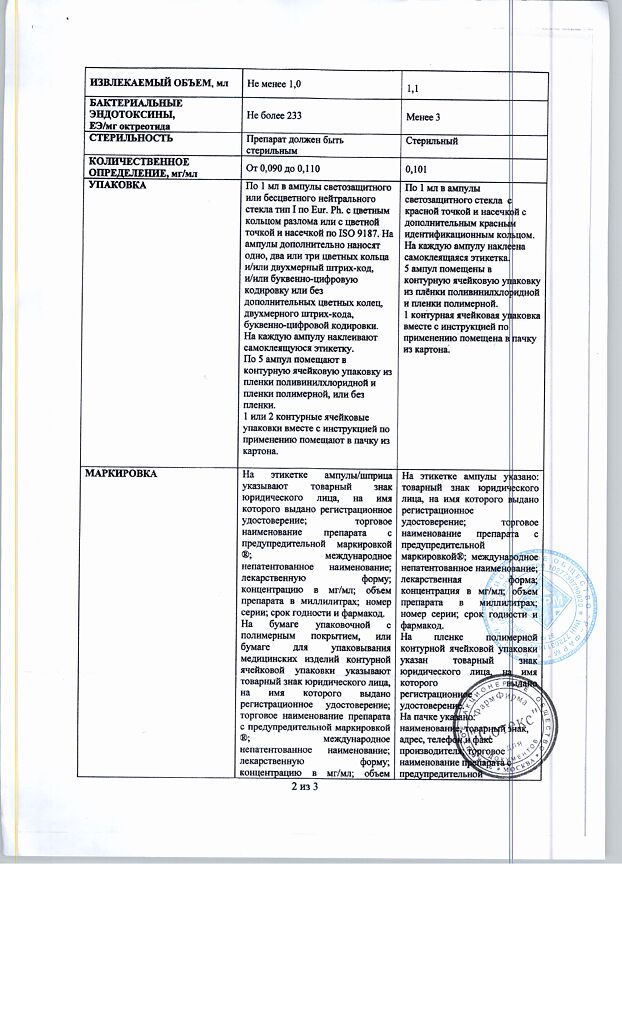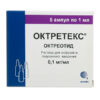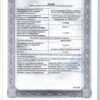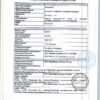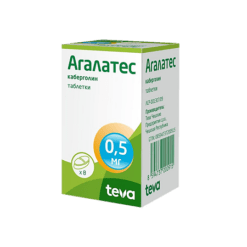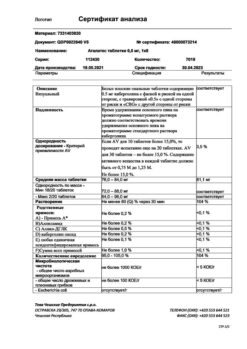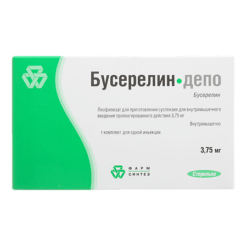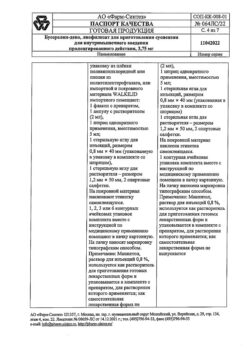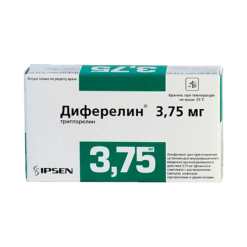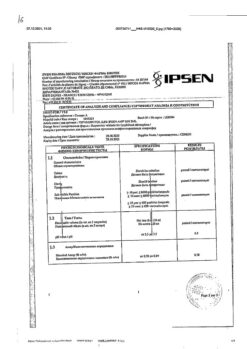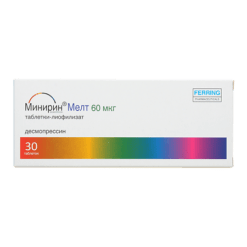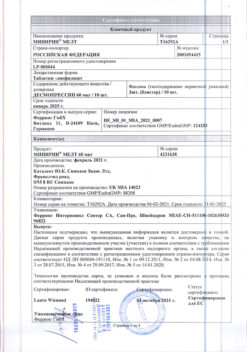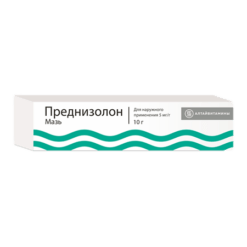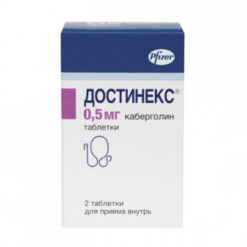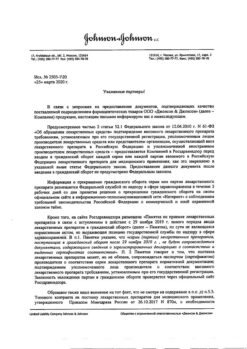No products in the cart.
Octetex 0.1 mg/ml 1 ml, 5 pcs.
€1.00
Out of stock
(E-mail when Stock is available)
Description
Octreotide is a synthetic analogue of somatostatin. It is a derivative of the natural hormone somatostatin and has similar pharmacological effects to it, but much longer duration of action.
Octreotide suppresses growth hormone (GH) secretion, both pathologically increased and caused by arginine, exercise and insulin hypoglycemia.
The drug also suppresses insulin, glucagon, gastrin, and serotonin secretion, both pathologically elevated and induced by food; it also suppresses insulin and glucagon secretion stimulated by arginine. Octreotide suppresses thyrotropin secretion induced by tyroliberin.
In contrast to somatostatin, octreotide suppresses GH secretion to a greater extent than insulin secretion, and its administration is not accompanied by subsequent hormone hypersecretion (such as GH in acromegaly patients).
In patients with acromegaly, octreotide reduces plasma GH and insulin-like growth factor (IGF-1) concentrations. A decrease in GH concentration of 50% or more is seen in 90% of patients, with a GH concentration value of less than 5 ng/mL achieved in about half of patients.
In most patients with acromegaly, octreotide reduces the severity of headache, soft tissue swelling, hyperhidrosis, joint pain and paresthesias. In patients with large pituitary adenomas, treatment with Octreotide may lead to some reduction in tumor size.
In secreting tumors of the gastroenteropancreatic endocrine system in cases of insufficient effectiveness of the therapy (surgery, hepatic artery embolization, chemotherapy including streptozotocin and fluorouracil) administration of Octreotide may lead to improvement of the course of the disease.
In carcinoid tumors, for example, administration of Octreotide may decrease the severity of flushing and diarrhea, which in many cases is accompanied by decreased plasma serotonin concentrations and renal excretion of 5-hydroxyindoleacetic acid.
In tumors characterized by hyperproduction of vasoactive intestinal peptide (VIP), use of octreotide leads in most patients to reduction of severe secretory diarrhea and, accordingly, to improvement of patient’s quality of life.
At the same time, concomitant electrolyte disturbances, such as hypokalemia, are reduced, allowing enteral and parenteral administration of fluids and electrolytes to be cancelled. In some patients the progression of the tumor is slowed or stopped, its size and the size of liver metastases decrease.
The clinical improvement is usually accompanied by a decrease in plasma concentration of VIP or its normalization. In glucagonomas, use of octreotide results in a reduction of erythema migrans.
Octreotide has no significant effect on the severity of hyperglycemia in diabetes mellitus, and the need for insulin or oral hypoglycemic agents usually remains unchanged.
The drug causes a decrease in diarrhea, which is accompanied by an increase in body weight. Although decrease in plasma glucagon concentration under the influence of octreotide is transient, clinical improvement remains stable during the whole period of using the drug.
In patients with gastrinomas/Zollinger-Ellison syndrome, when using octreotide as monotherapy or in combination with proton pump inhibitors or H2-histamine receptor blockers may decrease hypersecretion of hydrochloric acid in the stomach, gastrin plasma concentrations, and reduce the severity of diarrhea and flushes.
In patients with insulinomas octreotide decreases the level of immunoreactive insulin in blood (this effect may be transient, about 2 hours). In patients with operable tumors, Octreotide can provide restoration and maintenance of normoglycemia in the preoperative period.
In patients with inoperable benign and malignant tumors, glycemic control may improve without a simultaneous prolonged decrease in blood insulin concentration.
In patients with rare tumors that are hyperproducing the GH releasing factor (somatoliberinomas), octreotide reduces the severity of acromegaly symptoms. This is due to suppression of GH releasing factor and GH secretion itself.
The hypertrophy of the pituitary gland may then decrease. In refractory diarrhea in AIDS patients, use of octreotide leads to complete or partial normalization of stools in about 1/3 of patients with diarrhea uncontrolled by adequate antimicrobial and/or antidiarrheal therapy.
In patients who are scheduled for pancreatic surgery, the use of Octreotide during and after surgery reduces the incidence of typical postoperative complications (e.g., pancreatic fistulas, abscesses, sepsis, postoperative acute pancreatitis).
In bleeding from esophageal and gastric variceal veins in cirrhotic patients, use of octreotide in combination with specific treatments (e.g., sclerosing therapy) results in more effective bleeding control and early rebleeding, reduced transfusion volume and improved 5-day survival.
The mechanism of action of octreotide is thought to be related to reduction of organ blood flow through suppression of vasoactive hormones such as VIP and glucagon.
Pharmacokinetics
Intake
After p/k administration, octreotide is quickly and completely absorbed. Tmax of Octreotide in plasma is within 30 min.
Distribution
The binding to plasma proteins is 65%. The binding of Octreotide to blood cells is extremely insignificant. Vd is 0.27 l/kg.
Excretion
T1/2 after p/c administration of Octreotide is 100 min. After IV administration, excretion of Octreotide occurs in 2 phases, with T1/2 of 10 and 90 min, respectively. Most of octreotide is excreted through the intestine, about 32% – unchanged by the kidneys. Total clearance is 160 ml/min. In elderly patients octreotide clearance decreases and T1/2 increases. In severe CPN, clearance is decreased by half.
Indications
Indications
Active ingredient
Active ingredient
Composition
Composition
Active substance:
octreotide acetate (in terms of octreotide)0.1 mg;
Auxiliary substances:
Lactic acid, 3.4 mg;
Mannitol, 45 mg;
sodium bicarbonate – to pH 3.9-4.5;
water for injection – up to 1 ml
How to take, the dosage
How to take, the dosage
Subcutaneously, intravenously by IV drip.
Acromegaly: p/k, at an initial dose of 0.05-0.1 mg at 8 or 12-hour intervals. Subsequently, dose selection is based on monthly determinations of GH concentrations in blood (target GH concentration <2.5 ng/ml; IGF-1 within normal values), analysis of clinical symptoms and tolerability of the drug.
In most patients, the optimal daily dose is 0.2-0.3 mg.
The maximum dose of 1.5 mg/day should not be exceeded. In patients receiving octreotide at a stable dose, GH concentrations should be determined every 6 months. If after 3 months of treatment with Octreotide there is no sufficient decrease of GH concentration and improvement of clinical picture of the disease, the therapy should be stopped.
Tumors of the gastroenteropancreatic endocrine system: by injection, in an initial dose of 0.05 mg 1-2 times per day.
Thereafter, depending on the clinical effect achieved, the effect on the concentration of hormones produced by the tumor (in the case of carcinoid tumors, the effect on renal excretion of 5-hydroxyindoleacetic acid) and tolerability, the drug dose can be gradually increased to 0.1-0.2 mg 3 times/day. In exceptional cases, higher doses may be required.
The maintenance doses of the drug should be chosen individually. In carcinoid tumors, if therapy with octreotide at the maximum tolerated dose for 1 week has not been effective, treatment should not be continued.
Refractory diarrhea in AIDS patients: p/c, in an initial dose of 0.1 mg 3 times daily. If diarrhea does not subside after 1 week, the dose is increased individually (in case of normal tolerance), up to 0.25 mg 3 times per day. If during 1 week of treatment with Octreotide (in dose of 0.25 mg 3 times daily) there is no improvement, the therapy should be stopped.
Prevention of complications after pancreatic surgery: p/k, first dose of 0.1 mg 1 hour before laparotomy, after surgery – 0.1 mg 3 times/day for 7 subsequent days.
Bleeding from varices of the esophagus and stomach: IV drops at a rate of 0.025 mg/h for 5 days.
Particular patient groups
Patients who are elderly. There are currently no data to suggest that the tolerability of octreotide is reduced in the elderly and that a change in dosing regimen is required for them.
Disorders of liver function. Adjustment of the maintenance dose in patients with impaired liver function is recommended.
Kidney function abnormalities. In patients with impaired renal function, correction of the dosing regimen of Octreotide is not required.
Children. There is limited experience with octreotide in children.
The rules for use of the drug
Introduction by injection.
Patients who inject octreotide themselves should get detailed instructions from their physician or nurse: warm the solution to room temperature before injection to help reduce discomfort at the injection site; do not inject the product in the same place at short intervals; open the ampoules immediately before injecting; discard the unused amount of solution.
Intravenous drip administration. If it is necessary to administer Octreotide by IV drip injection, the contents of one ampoule containing 0.1 mg of the active substance should be diluted in 60 ml of 0.9% sodium chloride solution. Octreotide retains physical and chemical stability at temperatures below 25°C for 24 h in sterile 0.9% sodium chloride solution or 5% dextrose solution in water.
However, since octreotide may affect glucose metabolism, it is preferable to use 0.9% sodium chloride solution. Before IV administration, the ampoule should be carefully inspected for discoloration of the solution and the presence of foreign particles.
In order to avoid microbial contamination, diluted solutions should be used immediately after preparation. If the solution will not be used immediately, it should be stored at 2-8 °C. The solution should be warmed to room temperature before administration. The total time between dilution, storage in the refrigerator and completion of solution administration should not exceed 24 h.
Interaction
Interaction
Pharmacokinetic
Decreases absorption of cyclosporine, slows absorption of cimetidine.
The dosing regimen of concomitantly used diuretics, β-adrenoblockers, BKK, oral hypoglycemic agents, glucagon should be corrected.
The combined use of Octreotide and bromocriptine increases the bioavailability of bromocriptine.
It reduces the metabolism of substances metabolized with the participation of cytochrome P450 system enzymes (may be due to inhibition of GH). Since such effects of Octreotide cannot be excluded, caution should be exercised when prescribing drugs that are metabolized by the cytochrome P450 system and have a narrow range of therapeutic concentrations (e.g. quinidine, terfenadine).
Special Instructions
Special Instructions
In pituitary tumors, patients receiving octreotide should be closely monitored because the tumors may increase in size with the development of narrowing of the visual fields. In these cases, other treatment options should be considered.
The treatment of gastroenteropancreatic endocrine tumors may rarely result in a sudden relapse of symptoms.
The incidence of gastrointestinal side effects can be reduced by increasing the time between meals or before bedtime.
In patients with insulinomas, an increase in the severity and duration of hypoglycemia may be noted during treatment. Fluctuations in blood glucose concentrations may be reduced by administering smaller doses more frequently. During treatment, systematic monitoring of blood glucose concentration is necessary, especially in patients with bleeding from esophageal varices in liver cirrhosis.
In patients with type 1 diabetes mellitus, octreotide may decrease the need for insulin. In patients without diabetes mellitus and with type 2 diabetes with partially preserved insulin secretion, administration of Octreotide may lead to postprandial hyperglycemia. Since after bleeding from esophageal and gastric varices there is an increased risk of developing type 1 diabetes mellitus, and patients with diabetes mellitus may also have changes in insulin requirements, in these cases systematic monitoring of blood glucose concentration is necessary.
The use during pregnancy and lactation only with absolute indications (see Contraindications, Caution, Use in pregnancy and lactation).
Recommendations for management of patients during treatment with Octreotide® regarding gallstone formation
1. Patients should have a preliminary gallbladder ultrasound before prescribing Octreotide.
2. During treatment with Octreotide®, repeated ultrasounds of the gallbladder should be performed, preferably at 6-12 month intervals.
3 If gallstones are detected before the start of treatment, the potential benefits of octreotide therapy should be evaluated against the possible risks associated with their presence. There is no evidence of any adverse effect of octreotide on the course or prognosis of pre-existing gallstones.
Management of patients who develop gallstones during treatment with Octreotide®
1. Asymptomatic gallstones. Use of Octreotide may be discontinued or continued according to a benefit/risk assessment. In either case, it is not necessary to do anything other than continue monitoring, making it more frequent if necessary.
2. Gallbladder stones with clinical symptoms. The use of octreotide can be discontinued or continued according to a benefit/risk assessment. In either case, the patient should be treated as in other cases of gallstone disease with clinical manifestations.
Medication includes bile acid combinations (e.g., chenodeoxycholic acid at a dose of 7.5 mg/kg/day with the same dose of ursodeoxycholic acid) with ultrasound monitoring until the stones have completely disappeared.
Impact on the ability to drive vehicles and operate machinery.
Some side effects of Octreotide may adversely affect the ability to drive vehicles and operate other mechanisms requiring increased concentration and rapid psychomotor reaction speed.
In this regard, caution is recommended when such symptoms occur when driving or operating machinery requiring increased concentration.
Contraindications
Contraindications
Hypersensitivity to octreotide or other components of the drug; children under 18 years of age.
With caution:
Side effects
Side effects
Gastrointestinal disorders: very common – diarrhea, abdominal pain, nausea, constipation, abdominal bloating, cholelithiasis; common – dyspepsia, vomiting, feeling of heaviness in the stomach, soft stool consistency, changed stool color, anorexia, cholecystitis, impaired colloidal stability of bile (formation of cholesterol microcrystals), hyperbilirubinemia, increased liver transaminase activity, steatorrhea (without malabsorption phenomena).
While excretion of fat with feces may increase, to date there is no evidence that long-term treatment with Octreotide may lead to nutritional deficiencies due to disorders of absorption (malabsorption); rarely – symptoms resembling acute intestinal obstruction: progressive abdominal bloating, pronounced pain in the epigastric region, abdominal wall tension, decreased glucose tolerance (due to suppression of insulin secretion), persistent hyperglycemia, hypoglycemia, acute pancreatitis (in the first hours or days of drug treatment).
Hepatic and biliary tract disorders: in single cases – acute hepatitis without cholestasis, hyperbilirubinemia, increased liver transaminase activity (after discontinuation of Octreotide liver transaminase activity in serum is normalized), ALP, GGT.
In prolonged use gallstones may form, development of reactive pancreatitis. The frequency of gastrointestinal side effects can be reduced by increasing the time intervals between meals and administration of Octreotide (see “Special Precautions”).
Nervous system disorders: very common – headache; common – dizziness.
Endocrine system disorders: very common – hyperglycemia; common – hypothyroidism/disorders of thyroid function (decreased concentration of TSH, total and free T4); hypoglycemia, impaired glucose tolerance.
Systemic diseases: in some cases – bradycardia.
Local reactions: very often – pain, itching or burning sensation, redness and swelling at the injection site (usually goes away within 15 minutes). Local reactions can be reduced by using a room temperature solution or by injecting a smaller volume of a more concentrated solution.
Others: rare – skin allergic reactions; in some cases – anaphylactic reactions, transient alopecia.
Overdose
Overdose
Symptoms: transient decrease in heart rate, flushes to the face, spastic abdominal pain, diarrhea, nausea, feeling of emptiness in the stomach.
Treatment: symptomatic.
Pregnancy use
Pregnancy use
Experience with Octreotide in pregnant women is limited. Octreatex® should be used in pregnancy only if the expected benefit to the mother exceeds the potential risk to the fetus.
It is not known whether the drug passes into breast milk, so breastfeeding should be discontinued if the drug is used during lactation.
Similarities
Similarities
Additional information
| Shelf life | 2 years |
|---|---|
| Conditions of storage | In the dark place at 2-8 °C (do not freeze). |
| Manufacturer | PharmFirm Sotex, Russia |
| Medication form | solution for injections and infusions |
| Brand | PharmFirm Sotex |
Related products
Buy Octetex 0.1 mg/ml 1 ml, 5 pcs. with delivery to USA, UK, Europe and over 120 other countries.

